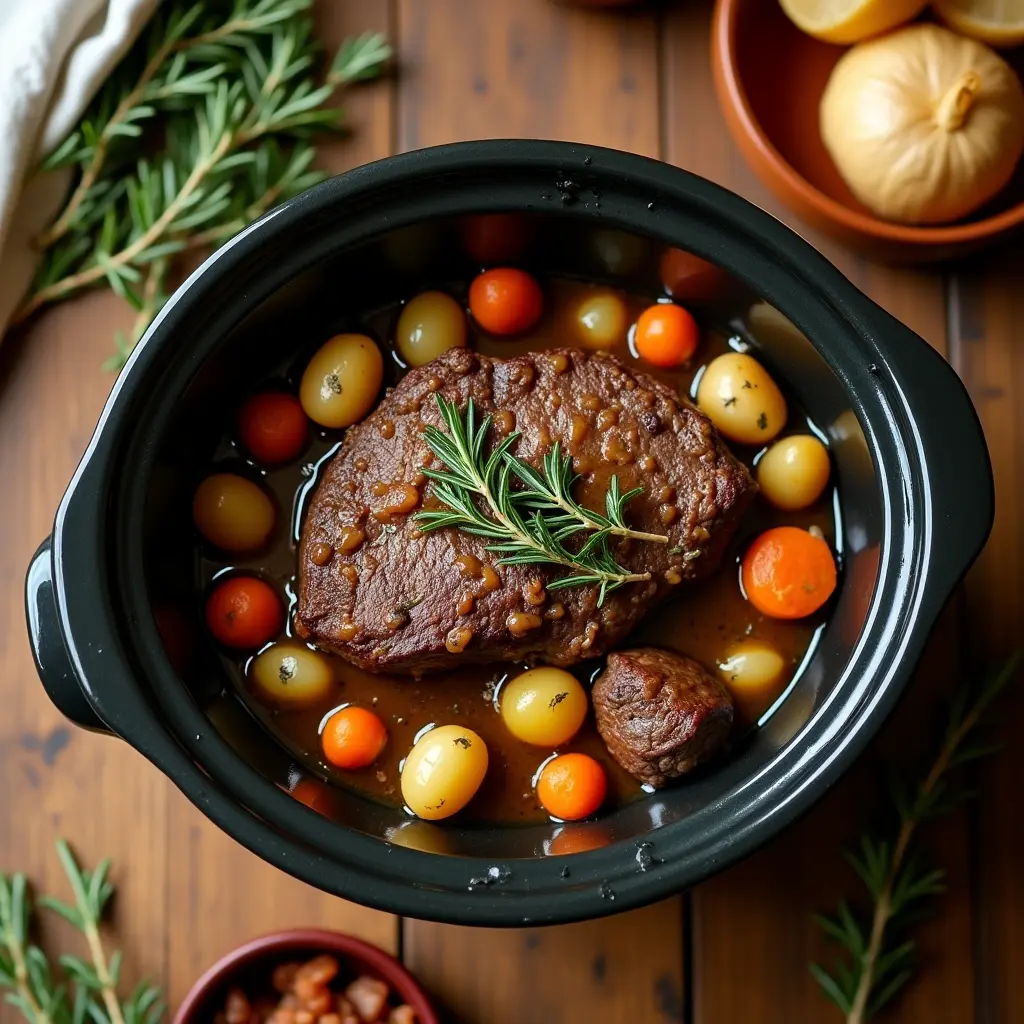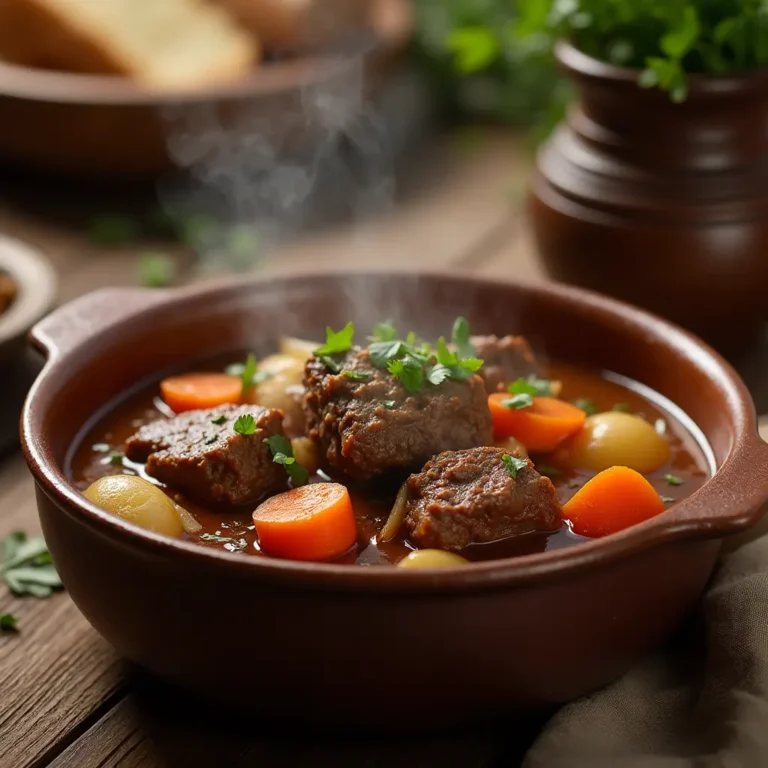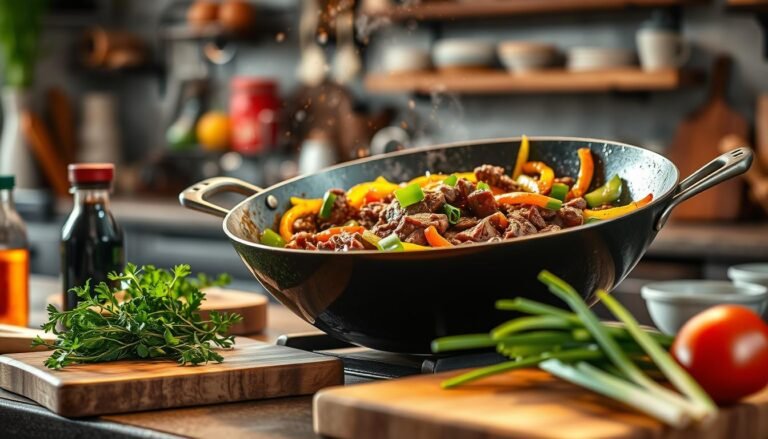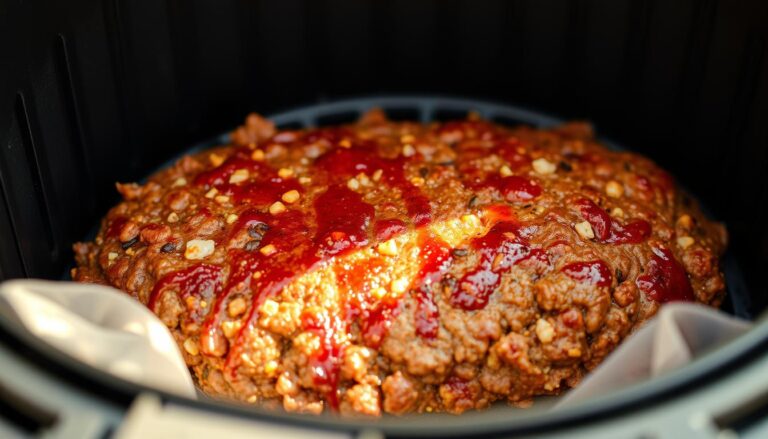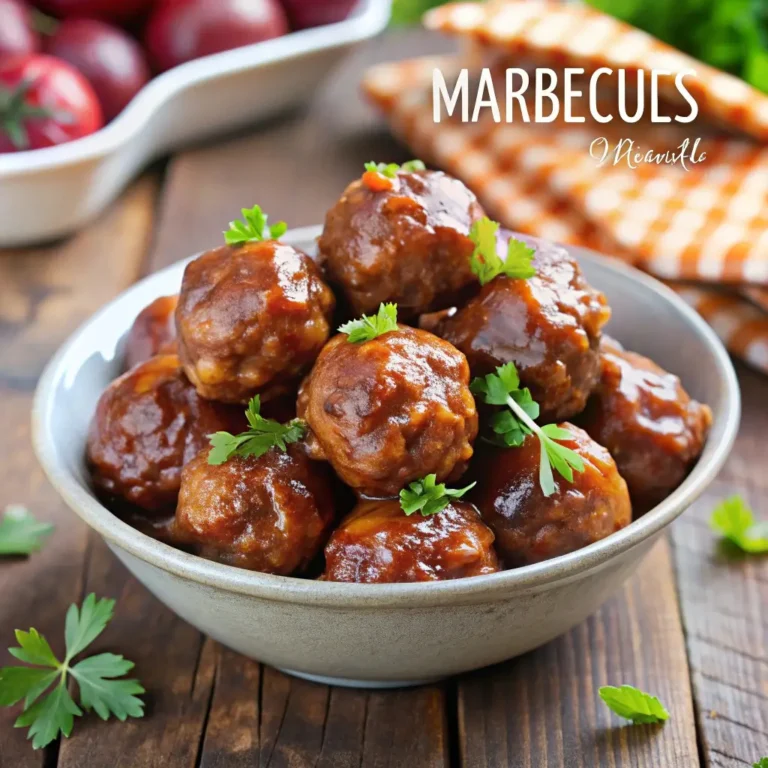Slow-Cooker Pot Roast Recipe
Coming home to the smell of slow-cooker pot roast is truly comforting. I remember my first time making one; it was almost as tasty as the meal. It’s perfect for busy days because you can prep it in the morning and forget about it.
The slow cooker turns a simple chuck roast into a tender, flavorful dish. It’s a favorite for family dinners, bringing everyone together.
Beef, fresh veggies, and herbs blend magically in this slow cooker. Each ingredient adds to the flavor, making it richer over time. It’s more than a meal; it’s a cozy experience that brings people closer.
Table of Contents
Key Takeaways
- A slow-cooker pot roast combines savory beef and flavorful vegetables.
- Preparation is minimal, making it a great option for busy schedules.
- The slow cooking process ensures tenderness and rich flavors.
- It’s a comforting dish perfect for family gatherings.
- A slow cooker transforms simple ingredients into a mouthwatering meal.
Introduction to Slow-Cooker Pot Roast
The classic pot roast is a beloved dish in many American homes. Its rich flavor and the tradition of family meals make it special. A slow-cooker pot roast fills the house with a delicious smell, inviting everyone to gather.
Preparing the best pot roast is easy with a slow cooker. Just add the meat, veggies, and seasonings in the morning. As the day goes by, the flavors blend, creating a tender dish that warms the heart. It’s more than food; it’s a symbol of family, tradition, and the joy of sharing meals.

Choosing the Right Cut of Meat
Choosing the right meat for pot roast is key to a delicious dish. Chuck roast is a top choice because of its marbling. This marbling helps the meat soak up flavors and get tender during cooking. Knowing about chuck roast and other cuts can help you pick the best for your meal.
Understanding Chuck Roast
Chuck roast comes from the cow’s shoulder. It’s flavorful and affordable. Its marbling makes it tender as it cooks slowly, adding depth to the flavor. Cooking it low and slow, like in a slow cooker, makes it juicy and perfect with veggies and potatoes.
Other Suitable Cuts
While chuck roast is popular, other cuts can also be great. Cuts like rump roast or bottom round roast can work, but they might not be as tender. They often lack the fat needed for slow cooking. So, I suggest choosing cuts that promise a moist and tasty meal. Here’s a quick comparison of these cuts:
| Cut of Meat | Flavor Profile | Tenderness | Best Cooking Method |
|---|---|---|---|
| Chuck Roast | Rich and savory | Very tender when slow-cooked | Slow cooking, braising |
| Rump Roast | Moderate flavor | Tender but can be dry | Roasting, slow cooking |
| Bottom Round Roast | Lean with a subtle taste | Less tender; may require longer cooking | Slow cooking, braising |
Ingredients for My Easy Pot Roast Recipe
Starting with the right ingredients is key to a perfect pot roast. My recipe includes essential parts that make it taste great and is good for you.
Essential Ingredients
To make a tasty pot roast, you’ll need:
- 2½ to 3-lb beef chuck roast
- 4-5 medium carrots, chopped
- 1-2 cups baby potatoes
- 1 large onion, quartered
- 3-4 cloves of garlic, minced
- 2 cups low-sodium beef broth
Choosing quality ingredients is important. Low-sodium beef broth is good for your heart and adds flavor. Carrots and potatoes add texture and nutrients.
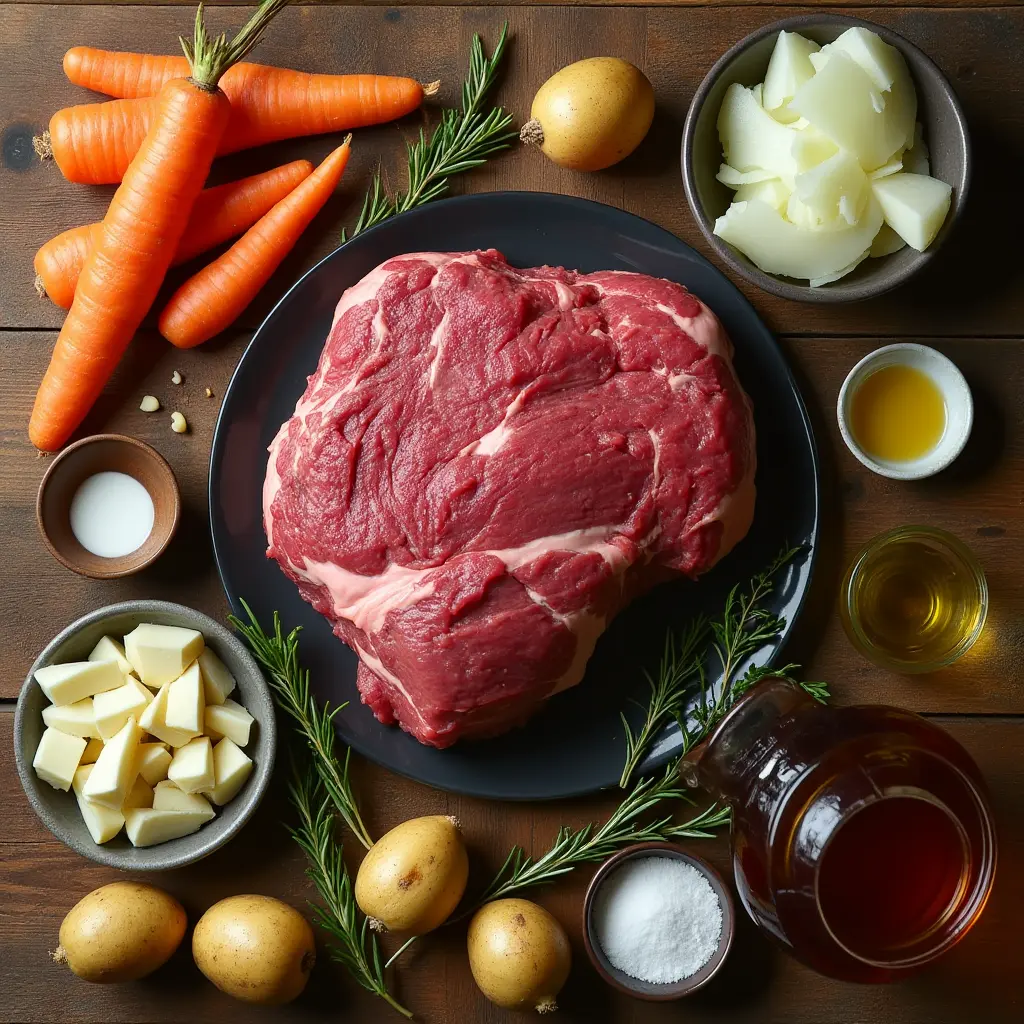
Recommended Seasoning
The right seasoning can make your meal even better. Here’s what I suggest:
- 2 teaspoons dried thyme
- 1 teaspoon black pepper
- 1 teaspoon salt (or to taste)
- 1 tablespoon Worcestershire sauce
Garlic and thyme are crucial in my recipe. Garlic helps lower cholesterol, and thyme boosts wellness. These herbs make the dish flavorful and aromatic.
Preparation Steps for a Classic Pot Roast
To make a classic pot roast, preparation is key. Quick prep makes cooking more fun. It lets me focus on getting everything perfect. Here are the essential steps for a delicious meal.
Quick Preparation Tips
Start by gathering all your ingredients. This makes work more efficient. Here are some quick tips:
- Chop vegetables into uniform sizes for even cooking.
- Measure out spices and seasonings in advance to save time.
- Ensure your pot is ready for use by preheating it.
How to Sear the Meat
Searing beef is crucial for flavor. I always use a hot skillet. Here’s how I do it:
- Heat a tablespoon of oil in the skillet until it shimmers.
- Season the beef generously with salt and pepper before placing it in the hot skillet.
- Allow the beef to sear for about 4-5 minutes on each side without moving it, creating a nice brown crust.
This initial searing locks in juices and adds amazing flavors. Following these steps ensures a great taste and look for your pot roast.
Cooking Method: The Slow Cooker Advantage
Slow cooking offers more than just great taste. It makes the meat incredibly tender. Over hours, the meat becomes so soft, it melts in your mouth. This makes the pot roast juicy and rich, enhancing its flavor.
Slow cooking also brings out the flavors of the ingredients. As the meat cooks, herbs and vegetables mix their tastes into the dish. This creates a delicious blend perfect for family dinners or cozy nights.
Using a slow cooker is also convenient. I can prep in the morning and let it cook while I’m busy. Coming home to a pot roast’s aroma makes dinner feel special.
Here’s a quick overview comparing traditional cooking methods with the slow cooker:
| Aspect | Traditional Cooking | Slow Cooker |
|---|---|---|
| Time Required | Hours of active cooking | Set it and forget it for several hours |
| Tenderness | Varies, often needs monitoring | Consistent tenderness with minimal effort |
| Flavor Integration | Depends on timing | Enhanced by long cooking times |
| Energy Use | High during short cooking times | Low, efficient energy consumption over a long period |
The slow cooker simplifies cooking and improves the dining experience. It’s my top choice for making the pot roast my family adores.
Pot Roast Cooking Tips
Cooking the perfect pot roast needs careful attention to details. This includes the right cooking times and temperatures. I cook my roast for 8-10 hours at a low and slow pace. This makes it tender and full of flavor. Knowing these key points will make your pot roast better.
Optimal Cooking Times and Temperatures
To get that tender quality, use the low setting on your slow cooker. Here’s a table with the best temperatures and cooking times:
| Temperature Setting | Cooking Time |
|---|---|
| Low | 8-10 hours |
| High | 4-6 hours |
The low setting is best for developing flavors. If you’re short on time, high can work. But low is better for tenderness.
Enhancing Flavor with Vegetables
Vegetables add flavor and nutrition to your meal. I use carrots, potatoes, and onions for a great taste. Timing is key when adding vegetables.
I add potatoes early, around the start. Carrots go in later to stay tender. This way, all ingredients cook well together.
Good timing makes your dish delicious and pretty. The right mix of ingredients and cooking times turns your meal into a feast of flavors.
Making the Perfect Gravy
Creating a rich and flavorful pot roast gravy can make your meal even better. I enjoy trying different ways to make the gravy taste great and match the roast perfectly. Whether using demi-glace concentrate for its deep flavor or thickening with cornstarch, the details matter a lot.
Gravy Options for Pot Roast
Adding demi-glace concentrate to your gravy makes it taste amazing. This sauce, made from brown stock and brown sauce, adds a rich umami flavor. Just mix it with water as the package says, then whisk it into your gravy until it tastes just right.
Tips for Thickening Gravy
For thickening gravy, I always choose cornstarch because it’s gluten-free. Here’s how to get a smooth, velvety gravy:
- Create a slurry: Mix 1 tablespoon of cornstarch with 1 to 2 tablespoons of cold water until it’s fully dissolved.
- Incorporate into the gravy: Slowly add the slurry to your simmering pot roast juices, whisking constantly to avoid lumps.
- Simmer and adjust: Keep stirring the gravy as it simmers until it’s the right thickness. For thicker gravy, add more cornstarch slurry.
This method lets you control the gravy’s thickness perfectly, making it a great match for the meat.
To get a smooth gravy, try reducing the liquid first. Simmer the juices over medium-high heat until they reduce by at least one-third. This will concentrate the flavors and thicken the gravy naturally. After thickening, taste and adjust the seasoning with salt, pepper, herbs, or spices.
To make your gravy even better, remove excess fat from the juices. Let them cool a bit, then skim off the fat with a spoon. A fat separator can also help, letting you pour off the leaner liquid. Using leftover pot roast juices adds depth and richness to your gravy, making your meal even more enjoyable.
Serving Suggestions for Your Pot Roast
Serving a delicious pot roast can be just as important as cooking it. I enjoy trying different side dishes to match the rich flavors of the meal. From classic choices to trendy options, there are many ways to serve pot roast and make your meal special.
Pairing Side Dishes
Choosing the right side dishes can really make your meal better. Here are some of my top picks:
- Mashed Potatoes: They’re creamy and buttery, perfect for soaking up the gravy.
- Green Beans: These add a fresh and vibrant touch to your plate.
- Cornbread: Sweet and hearty, it pairs well with the pot roast.
- Roasted Vegetables: A mix of seasonal veggies offers a crunchy and healthy contrast.
- Coleslaw: A tangy coleslaw can balance the richness of the roast.
Garnishing the Pot Roast
Garnishing your pot roast can make it look and taste better. Fresh herbs like rosemary or parsley can add a bright touch. I often sprinkle chopped herbs on top just before serving. You can also add a sprinkle of black pepper or a drizzle of balsamic glaze for a fancy look. A beautifully presented dish can impress your guests, making family gatherings even more special.
Using these serving suggestions can turn a simple meal into a memorable one.
Health Benefits of a Tender Pot Roast
Enjoying a hearty meal, pot roast is a standout. It’s not just tasty but also packed with health benefits. Choosing high-quality cuts, like grass-fed beef, boosts these benefits even more.
Protein and Nutritional Value
Beef is a top source of protein, B vitamins, and iron. A 3-ounce serving of cooked beef has about 22 grams of protein. This is key for muscle repair and keeping the immune system strong.
Beef also has B vitamins, like vitamin B12, which is crucial for making red blood cells and brain health. It also has heme iron, the best form of iron for carrying oxygen and energy. These nutrients are essential for overall health.
Adding veggies to pot roast makes it even better. Carrots, potatoes, and onions add fiber, vitamins, and minerals. Fiber helps with digestion and keeps cholesterol levels healthy. They also bring vitamins A and C, which are good for your eyes, skin, and immune system.
Minerals like potassium and magnesium in these veggies help control blood pressure and support muscles and nerves. This makes pot roast a meal that’s both satisfying and nutritious.
Why Choose Grass-Fed Beef
Grass-fed beef offers more health benefits than regular beef. It has two to four times more omega-3 fatty acids. These fats are good for your heart, brain, and reducing inflammation.
Omega-3s can lower heart disease risk and improve brain function. Grass-fed beef also has more antioxidants, like vitamin E, which protect cells and may lower cancer risk. It also has conjugated linoleic acid (CLA), which can help with body fat and immune function. Choosing grass-fed beef is a smart choice for those who care about nutrition.
| Nutrient | Conventional Beef | Grass-Fed Beef |
|---|---|---|
| Protein (per 3 oz) | 22 grams | 22 grams |
| Omega-3 Fatty Acids | Low | 2-4 times higher |
| Vitamin E | Lower levels | Higher levels |
| Conjugated Linoleic Acid (CLA) | Lower | Higher |
| Heme Iron | Available | Available |
Storing and Reheating Leftovers
After enjoying a delicious pot roast, I always focus on proper storage. It keeps the flavors and ensures safety. The best way is to use airtight containers for leftovers.
This method lets me store the pot roast in the fridge for up to four days. For longer storage, I freeze portions. It helps avoid food waste and allows for a meal later.
Reheating pot roast affects its flavor and texture. I prefer stovetop reheating for the gravy, as it stays smooth. For quick reheating, the microwave works well for the meat.
To keep the meat juicy, I cover it while reheating. This prevents it from drying out.
Mastering these storage and reheating techniques lets me enjoy pot roast for longer. It stays safe and delicious.
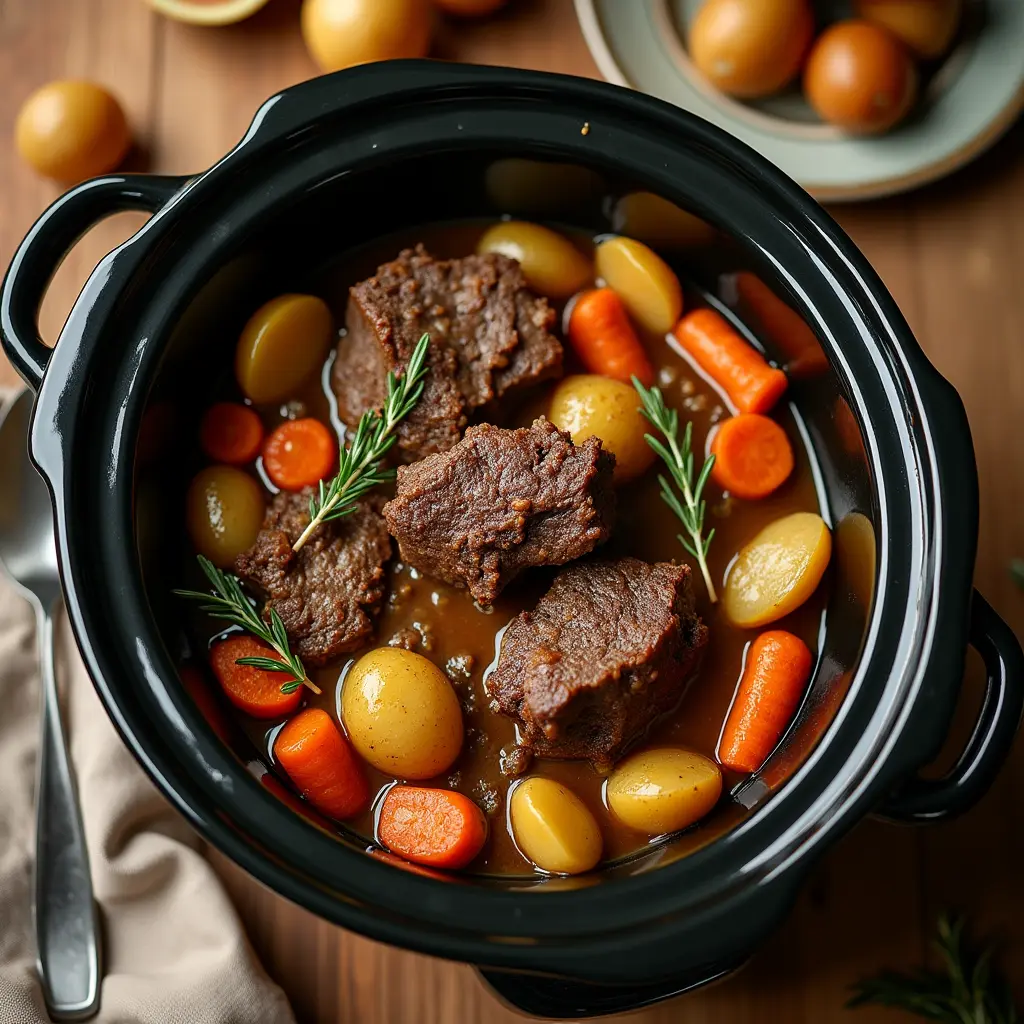
Experimenting with Variations of Pot Roast
Exploring different pot roast variations can make cooking more fun. The Mississippi pot roast is a great example. It adds spicy and tangy flavors to the classic dish. This makes dinner feel like a special event.
Mississippi Pot Roast Recipe
The Mississippi pot roast is known for its bold taste. To make it, you’ll need:
- 3 to 4 pounds of chuck roast
- 1 packet ranch dressing mix
- 1 packet au jus gravy mix
- 5 to 6 pepperoncini peppers
- 1/2 cup of beef broth
Just put the chuck roast in your slow cooker. Sprinkle the ranch and au jus mixes on top. Add the pepperoncini and beef broth. Cook on low for 8 hours for a tender result.
Seasoning Variations for Pot Roast
There are many pot roast seasoning ideas to try. Here are some favorites:
| Seasoning Idea | Main Ingredients | Flavor Profile |
|---|---|---|
| Cajun Style | Cajun seasoning, smoked paprika, garlic powder | Spicy, Smoky, Bold |
| Herb-Infused | Rosemary, thyme, bay leaves | Earthy, Aromatic |
| Italian Blend | Italian seasoning, marinara sauce | Savory, Tangy |
| BBQ Flavor | BBQ sauce, brown sugar | Sweet, Smoky |
Changing the seasonings lets you make the perfect pot roast. It’s a dish that can please everyone. Try these ideas to make mealtime exciting for your family.
Why This is the Best Pot Roast Recipe
This recipe is a family favorite, making countless dinners special. It’s more than a meal; it’s a mix of flavors that brings everyone together. It’s warm, comforting, and loved by both kids and adults every week.
Family Favorite Review
My family loves this pot roast recipe. They say it’s the best. The meat is tender, and the gravy is rich. My kids even ask, “Is it pot roast night?” every week.
The smell of it cooking makes dinner time exciting. It turns waiting into looking forward to a delicious meal together.
Easy Weeknight Meal
This recipe is a lifesaver on busy weeknights. It’s easy to prepare and cooks in just a few hours. It’s a healthy dinner that makes meal planning stress-free.
With this recipe, I can spend more time with my family. It’s a meal that nourishes both body and soul.
| Why We Love It | Description |
|---|---|
| Family Bonding | Brings everyone together around the dinner table. |
| Aromatic Appeal | Fills the house with a mouthwatering scent. |
| Comfort Food | A satisfying meal that warms the heart. |
| Time Saver | Simple preparation and cooking leave time for family. |
Conclusion
This slow-cooker pot roast is truly a simple yet rewarding dish. It’s easy to make, thanks to the slow cooker. Even the busiest cooks can make something special.
The aroma that fills your kitchen will make mealtime better. It brings your family together at the dinner table.
This easy pot roast recipe is not just tasty. It’s also healthy and can be made in many ways. You can stick to the classic or try new things. It’s sure to become a favorite in your home.
Try making this recipe and see how it warms your heart. It’s a great way to make a meal that everyone will love.
Every family has its own way of enjoying pot roast. So, invite your loved ones over. Let your kitchen be filled with laughter and love as you make this timeless dish together.

